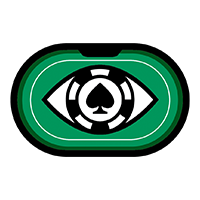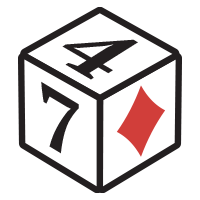Kyka decided to become a poker pro at 40 and started a blog on our Russian forum. He analyzed a hand from NL20, in which the opponent made a check-raise on the flop, bet the turn and checked on the river pair. The hero decided to push, hoping to knock out a straight.
But – is it worth bluffing in such a situation? To find out how the opponent should have played we asked a coach, Anton Nko1.

Opponent statistics:
There aren't many hands, a couple thousand hands, but conclusions can be made. Looks like a minus regular.
- 25/20/9.5 (VPIP/PFR/3bet)
- 26/50/44 (WTSD/WonSD/WWSF)
- 3bet BBvsBU 11% (solver 14%)
- Call BBvsBU 26% (solver 25%)
Preflop:
Standard open raise 42%, standard call in BB.
Flop:
The diagrams below show how the solver wants to c-bet the flop on the button on a texture with three high cards:

The high c-bet, as well as the use of large sizes on most such boards, is due to the fact that BTN has a big advantage – both in equity and its realization, and in the nut part. We have all the sets, as well as an advantage in nut straights. However, our texture is an exception, because the amount of AT in the BB range is even slightly higher in percentage terms than ours. This happens because AT rarely 3-bets preflop even with a solver, and in practice, most regs will always protect with a call. At the same time, straights are a decent part of both ranges, about 7%.
I like to bet small on this board with medium frequency. With our hand in particular, I will always bet, especially with a backdoor. Of course, this is a value bet.
The opponent makes a small raise. Let's first look at what the solver wants to play with:

The main hands for value raising are straights and a few combinations with two pairs, semi-bluffs are gutshots with backdoors. Gutshots can improve and block possible straights from the BTN. I am not sure how the local regular will build his range here. I think there will be significantly fewer semi-bluffs, however, I assume that two pairs will play this way more often (to exploit the insufficient check-raise on the BB, you can rangebet on the flop).
For us the solution is simple – our entire range either folds or calls. I don't see a raise here.
Here's what the solver thinks about it:

Overall, I would play more or less like this, though I would fold hands like A9, K7, K8, suited K and Q without backdoors, Jxs. Specifically with our hand, it's an easy call here.
Turn:
On the turn we get a flush draw. Otherwise the card is blank.
We get a bet of 3/4 of the pot.
If I were the opponent, I would lean towards an overbet. We want to get more with the nuts, especially since the board can still get worse. And get a more comfortable SPR, so that the decisions on the river are easier. Considering that the real opponent will have fewer bluffs here and more than two pairs in the range, I don’t see any other sizings except for an overbet. Solver, by the way, too.
Here's a turn solver strategy with a locked flop raising range if he's given a single sizing of 75%:

I think in reality the betting frequency will be much higher. The same KQ and KJ will definitely not be checked 100% of the time, and straights will be bet almost always.
The solver on BTN is protected like this:

Basically, we call with straights, sets, and flush draws. Interestingly, some of the AA's are folded.
Above I wrote that in reality a person will put much more broadly. For example, like this:

And again a simple decision for our hand, we call and move to the river.
River:
A card comes out that radically changes the structure of the board, and straights turn into bluffcatchers.
In general, this hand interested me even more from the point of view of how to play in the opponent's place. Because by the river he is essentially dripped and it is unclear how to properly defend in his place. Yes, he has full houses left in his range, but there are very few of them, despite the fact that we kept the range so that there would be more of them there. A solver along such a line would have almost nothing there.
80% of the BB range is straights, but the straights on the river have become bluffcatchers, and bad ones at that, since they don't block our nuts, of which we have a ton. Plus, it's worth considering that the field is underbluffing, which means there aren't many bluffs from the BTN. Again, I expect all the fulls and maybe some of the straights to continue to bet the river. This means there are even fewer strong hands in the check.
A solver is a master at finding balance with different inputs, but even it has a hard time here. Here's what his river play looks like as BB:

He checks 97% of his hands, trying to maintain at least some balance!
And here's what the solver does in place of BTN. Sizing is push, of course. There can't be any other here:

During the hand, I logically figured out that the opponent would not be able to adequately defend himself in this situation, so we can shove in anything. My hand is also good because it blocks the main category of the opponent's hands, namely, nut straights. The opponent thought for a long time before folding, I wouldn't be surprised if he folded AT. Solver plays part of the AT with a near-zero call, and folds part of the ones containing a heart. The heart is bad because it blocks my bluff range.
In a real situation, I, like 99% of regulars, would not have collected enough bluffs here and calling on BB with AT would definitely be bad. At the same time, we laid down a BB range that contains almost no bluff part, which means in practice pushing the river with AQs is even better.
I am happy with my hand. In this hand, I had some questions about the opponent's play. How to play your range so as not to get into an awkward situation and not play a guessing game? So far, I am absolutely sure that the opponent should have played differently. And an interesting observation on the flop: given that the field definitely raises less than the solver advises, you can play with a rangebet.
How Does the Coach Feel About This Hand?
– Anton Nko1
My main recommendation is to rely less on solver recommendations when playing at low limits and pay more attention to showdowns and what hands opponents have in different lines.
The lower the limit, the more deviations our opponents have from GTO. I would use it like this: “Oh, I watched this spot in simulation and here the solver folds such and such hands, but my opponents do not fold them, or fold few, so I will bet WIDE for value.” Or vice versa, they fold too much. It is important that we identify a bias in one direction or another, often “helping” ourselves with sizing. We give up, knowing that in this situation our opponents have a hellish underbluff, etc. To do this, we will need not only to work with the solver, but also the ability to observe and analyze, as well as research into the limits being played. In essence, this is an exploit.
Flop:
Definitely our texture. We can bet heavily, up to 100% c-bet for 1/3. There is another strategy, with more active use of check-back and different flop sizings. Our hand is a good candidate for checking. But people are very bad at check-raising, they are often afraid to inflate pots out of position with a wide (and capped) range preflop, especially on such textures. So I bet 1/3 FOR the hero line.
Having received a raise on such a board, I would definitely be tense, since it is heavily biased towards value. I would play honestly and not try to come up with some 3-bets as a bluff. With our hand, a standard call.
Turn:
There are no options here. We caught a backdoor and the opponent's sizing is pleasant. The easiest call in position. If a card of the wrong suit had come, I would have easily given up.
River:
There is a very interesting nuance here. People in general use checks very poorly. They make a lot of mistakes, especially in such lines. It is much easier for the opponent to put his full house than to come up with a complex line through check-raise, bet or check-push. There is fear in this check. From the straight I would expect a block-bet or bet-fold. I think this is the most common layout.
Although I defined the opponent's range from the flop as "pretty tight", it will be difficult for hands like KQ and a straight on T9, we have all the fulls and nut straights by the river. Turning our hand into a bluff is a good plan. I would mostly push hands with Qh. Another great merge-push would be with T9 from our side. Hero size is 👍
If you look at the hand as a whole, you would have played exactly like the hero.
– How can an opponent play his range without getting into an awkward situation and playing a guessing game on the river?
If I were BB, I would have chosen a bigger sizing on the turn. I would definitely not have used a push on the river, I would have blockbet/called with all full houses and some AT.

















